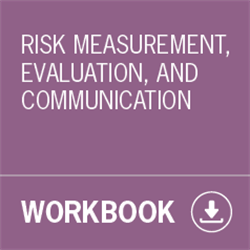Risk Measurement, Evaluation, and Communication Workbook
List Price
$3,500
Member Price
$500
Product code:
641168
A hard copy version of The Risk Measurement, Evaluation, and Communication Workbook. This workbook is a practical guide to understanding the mechanisms available to size risks along with a guide to their usage and ways to communicate the results.

Members qualify for savings.
Log in to see if you qualify for a lower rate, or become a member to save as much as $3,000 or more.
Item Details
Hard copy version. View a complete list of workbooks.
As a membership benefit, individual RMA members can enjoy free downloads of the ERM workbooks. A free hard copy of each workbook is also available. (One copy per institution. Please contact your Regional Manager.)
This is available to Professional members for the list price.
The Risk Measurement, Evaluation, and Communication Workbook addresses 1) the mechanisms available to size risks in order to compare them to each other and to prioritize risk mitigation activities, 2) the strengths, weaknesses, and limits of each approach, 3) the “watch-outs” that are especially important when sizing, 4) the output that will ultimately be needed for the next step (response), and 5) the best ways to communicate the results.
In this workbook you will find:
- Alternative approaches to sizing risk.
- The three factors to consider when sizing risk:
- Severity: What is the impact if the risk materializes?
- Likelihood: Given the risk scenario, what is the likelihood that it will happen?
- Frequency: Given the risk scenario, how often could the risk materialize?
- How to use the risk measurement process to create risk metrics.
- Tools that, when combined with internal discussion, debate, and challenge, can help create a sustainable methodology for consistent risk measurement.
The benefits:
- Develop an understanding of the individual and aggregate risks of your bank.
- Know which risk mitigation efforts to prioritize.
- Be able to cascade aggregate risk (through limits) to your business units.
- Engage in more fact-based discussions around capital, earnings, and liquidity at risk.
